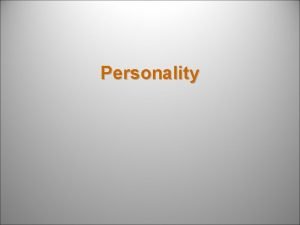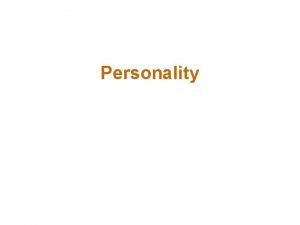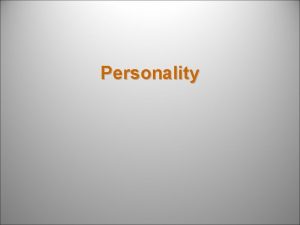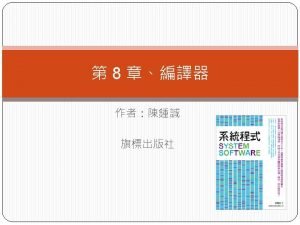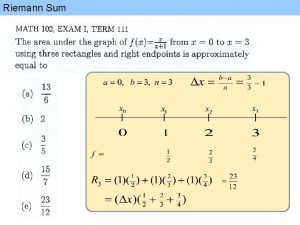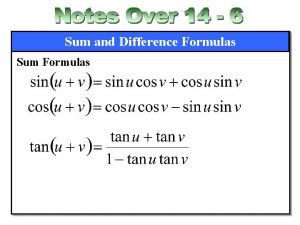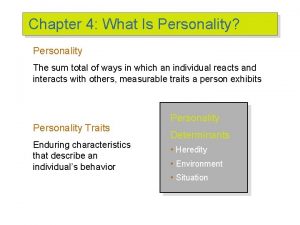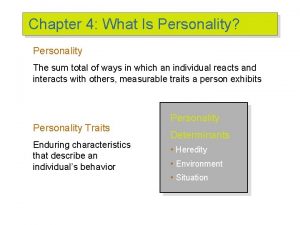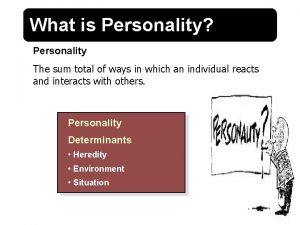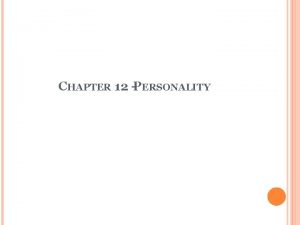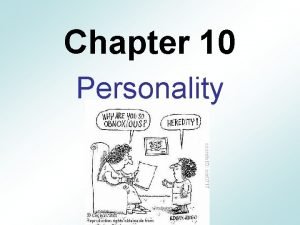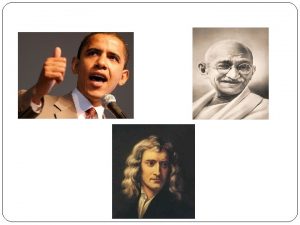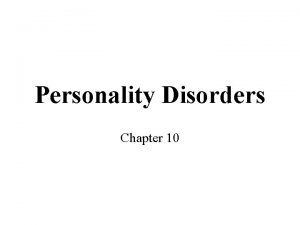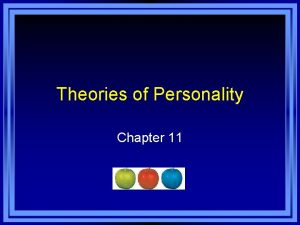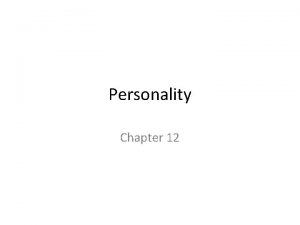Chapter 4 What Is Personality Personality The sum























- Slides: 23

Chapter 4: What Is Personality? Personality The sum total of ways in which an individual reacts and interacts with others, measurable traits a person exhibits Personality Traits Enduring characteristics that describe an individual’s behavior Personality Determinants • Heredity • Environment • Situation

The Myers-Briggs Type Indicator (MBTI) A personality test that taps four characteristics and classifies people into 1 of 16 personality types Personality Types • Extroverted vs. Introverted (E or I) • Sensing vs. Intuitive (S or N) • Thinking vs. Feeling (T or F) • Judging vs. Perceiving (P or J) Score is a combination of all four (e. g. , ENTJ)

Meyers-Briggs (cont’d) A Meyers-Briggs Score – Can be a valuable too for self-awareness (i. e. , teambuilding and workplace communication) and career guidance – It is *VERY* popular in industry and widely used BUT – It should not be used as a selection tool because it has not been related to job performance!

The Big Five Model Extroversion Sociable, gregarious, and assertive Agreeableness Good-natured, cooperative, and trusting Conscientiousness***(VIP) Responsible, dependable, persistent, and organized Emotional Stability Calm, self-confident, secure under stress (positive), versus nervous, depressed, and insecure under stress (negative) Openness to Experience Curious, imaginative, artistic, and sensitive

Values Ø Definition: Mode of conduct or end state is personally or socially preferable (i. e. , what is right and good) Ø Value System: A hierarchy based on a ranking of an individual’s values in terms of their intensity Ø Values tend to be relatively stable and enduring Ø Provide understanding of the attitudes, motivation, and behaviors of individuals and cultures Ø Influence our perception of the world around us

Types of Values Terminal Values Desirable end-states of existence; the goals that a person would like to achieve during his or her lifetime Instrumental Values Preferable modes of behavior or means of achieving one’s terminal values

Achieving Person-Job Fit Personality-Job Fit Theory (Holland) Identifies six personality types and proposes that the fit between personality type and occupational environment determines satisfaction and turnover Personality Types • Realistic • Investigative • Social • Conventional • Enterprising • Artistic

Chapter FIVE Perception and Individual Decision Making

What Is Perception, and Why Is It Important? Perception A process by which individuals organize and interpret their sensory impressions in order to give meaning to their environment. • People’s behavior is based on their perception of what reality is, not on reality itself. • The world as it is perceived is the world that is behaviorally important.

Factors that Influence Perception

Person Perception: Making Judgments About Others Attribution Theory When individuals observe behavior, they attempt to determine whether it is internally or externally caused. Internal = Something within the person External = Something outside of the person

Errors and Biases in Attributions Fundamental Attribution Error The tendency to underestimate the influence of external factors and overestimate the influence of internal factors when making judgments about the behavior of others In general, we tend to blame the person first, not the situation. Self-Serving Bias The tendency for individuals to attribute their own successes to internal factors while putting the blame for failures on external factors When I “succeed”, it is because I am smart, good, skilled, etc.

Frequently Used Shortcuts in Judging Others Selective Perception People selectively interpret what they see on the basis of their interests, background, experience, and attitudes.

Frequently Used Shortcuts in Judging Others Halo Effect Drawing a general impression about an individual on the basis of a single characteristic Contrast Effects Evaluation of a person’s characteristics that are affected by comparisons with other people recently encountered who rank higher or lower on the same characteristics

Specific Applications in Organizations Ø Employment Interview – Perceptual biases of raters affect the accuracy of interviewers’ judgments of applicants Ø Performance Expectations – Self-fulfilling prophecy (Pygmalion effect): The lower or higher performance of employees reflects preconceived leader expectations about employee capabilities. Ø Ethnic Profiling – A form of stereotyping in which a group of individuals is singled out—typically on the basis of race or ethnicity —for intensive inquiry, scrutinizing, or investigation

Specific Applications in Organizations (cont’d) Ø Performance Evaluations – Appraisals are often the subjective (judgmental) perceptions of appraisers of another employee’s job performance.

The Link Between Perceptions and Individual Decision Making Problem A perceived discrepancy between the current state of affairs and a desired state Decisions Perception of the Decision Maker Choices made from among alternatives developed from data perceived as relevant Outcomes

Assumptions of the Rational Decisionmaking Model Describes how individuals should behave in order to maximize some outcome Model Assumptions • Problem clarity • Known options • Clear preferences • Constant preferences • No time or cost constraints • Maximum payoff

Steps in the Rational Decision-making Model 1. Define the problem. 2. Identify the decision criteria. 3. Allocate weights to the criteria. 4. Develop the alternatives. 5. Evaluate the alternatives. 6. Select the best alternative.

How Are Decisions Actually Made in Organizations? Bounded Rationality Individuals make decisions by constructing simplified models that extract the essential features from problems without capturing all their complexity.

How Are Decisions Actually Made in Organizations? (cont’d) Ø How/Why problems are Identified – Visibility over importance of problem • Attention-catching, high profile problems • Desire to “solve problems” – Self-interest (if problem concerns decision maker) Ø Alternative Development – “Satisficing” - seeking the first alternative that solves problem – Engaging in incremental rather than unique problem solving through successive limited comparison of alternatives to the current alternative in effect

Organizational Constraints on Decision Makers Ø Performance Evaluation – Evaluation criteria influence the choice of actions Ø Reward Systems – Decision makers make action choices that are favored by the organization Ø Formal Regulations – Organizational rules and policies limit the alternative choices of decision makers Ø System-imposed Time Constraints – Organizations require decisions by specific deadlines Ø Historical Precedents – Past decisions influence current decisions

Toward Reducing Bias and Errors Ø Focus on goals. – Clear goals make decision making easier and help to eliminate options inconsistent with your interests. Ø Look for information that disconfirms beliefs. – Overtly considering ways we could be wrong challenges our tendencies to think we’re smarter than we actually are. Ø Don’t try to create meaning out of random events. – Don’t attempt to create meaning out of coincidence. Ø Increase your options. – The number and diversity of alternatives generated increase the chance of finding an outstanding one.
 Int sum(int a int n) int sum=0 i
Int sum(int a int n) int sum=0 i Define sum total
Define sum total Hình ảnh bộ gõ cơ thể búng tay
Hình ảnh bộ gõ cơ thể búng tay Ng-html
Ng-html Bổ thể
Bổ thể Tỉ lệ cơ thể trẻ em
Tỉ lệ cơ thể trẻ em Gấu đi như thế nào
Gấu đi như thế nào Chụp phim tư thế worms-breton
Chụp phim tư thế worms-breton Chúa sống lại
Chúa sống lại Kể tên các môn thể thao
Kể tên các môn thể thao Thế nào là hệ số cao nhất
Thế nào là hệ số cao nhất Các châu lục và đại dương trên thế giới
Các châu lục và đại dương trên thế giới Công thức tiính động năng
Công thức tiính động năng Trời xanh đây là của chúng ta thể thơ
Trời xanh đây là của chúng ta thể thơ Cách giải mật thư tọa độ
Cách giải mật thư tọa độ 101012 bằng
101012 bằng Phản ứng thế ankan
Phản ứng thế ankan Các châu lục và đại dương trên thế giới
Các châu lục và đại dương trên thế giới Thơ thất ngôn tứ tuyệt đường luật
Thơ thất ngôn tứ tuyệt đường luật Quá trình desamine hóa có thể tạo ra
Quá trình desamine hóa có thể tạo ra Một số thể thơ truyền thống
Một số thể thơ truyền thống Cái miệng nó xinh thế chỉ nói điều hay thôi
Cái miệng nó xinh thế chỉ nói điều hay thôi Vẽ hình chiếu vuông góc của vật thể sau
Vẽ hình chiếu vuông góc của vật thể sau Biện pháp chống mỏi cơ
Biện pháp chống mỏi cơ

